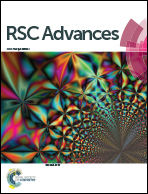Molecular engineering of new phenothiazine-based D–A–π–A dyes for dye-sensitized solar cells†
Abstract
A new series of phenothiazine-based D–A–π–A dyes PZ-1–4 have been designed, synthesized and fully characterized by 1H, 13C NMR, HRMS, UV-vis, fluorescence, and cyclic voltammetry spectroscopy. Benzothiadiazole was introduced into the D–π–A dyes as an additional acceptor. Various donors and new π-spacers have been connected to phenothiazine skeleton on opposite sides to generate PZ-2–4 dyes. The DSSC devices have been systematically investigated by photoelectrochemical experiments, the solar cell of PZ-4 with a simple hexyloxyphenyl group achieves the highest photoelectric conversion efficiency of 6.35%. Density functional theory (DFT) calculation results demonstrate that the large dihedral angle (36.3°) between the π-spacer and phenothiazine in PZ-4 induces better charge separation. Its largest semicircle at intermediate frequencies in electrochemical impedance spectroscopy (EIS) prevents the recombination of photoelectrons injected into the titanium dioxide (TiO2) conductive band with I3− in electrolyte, which might be caused by the blocking interaction of the hexyloxy group dye.


 Please wait while we load your content...
Please wait while we load your content...